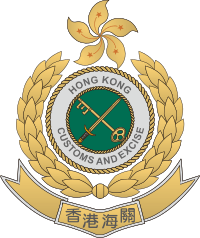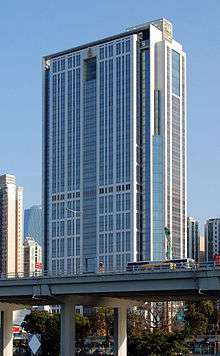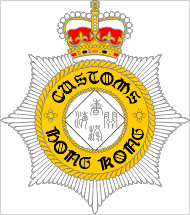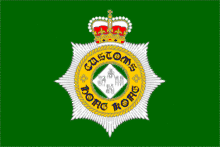Customs and Excise Department (Hong Kong)
The Customs and Excise Department (C&ED) is a government agency responsible for the protection of the Hong Kong Special Administrative Region against smuggling; the protection and collection of revenue on dutiable goods on behalf of the Hong Kong Government; the detection and deterrence of drug trafficking and abuse of controlled drugs; the protection of intellectual property rights; the protection of consumer interests; and the protection and facilitation of legitimate trade and upholding Hong Kong's trading integrity .
| 香港海關 | |
 | |
 Customs Headquarters Building | |
| Agency overview | |
|---|---|
| Formed | 1841 |
| Superseding agency |
|
| Jurisdiction | |
| Headquarters | 222 Java Road, North Point |
| Employees | 7,387 (January 2019) |
| Annual budget | HK$4,426.3 million (2018–19) |
| Agency executives |
|
| Parent agency | Security Bureau (Hong Kong) |
| Website | www.customs.gov.hk |
| Customs and Excise Department | |||||||||||||
|---|---|---|---|---|---|---|---|---|---|---|---|---|---|
| Traditional Chinese | 香港海關 | ||||||||||||
| Simplified Chinese | 香港海关 | ||||||||||||
| |||||||||||||
 |
|
Politics and government of Hong Kong |
|
|
|
Legislature |
|
Court of Final Appeal
Special courts and tribunals: |
|
|
Related topics |
History


Hong Kong Customs, originally known as the Preventive Service, was founded in 1909. Initially it was responsible to collect the newly imposed duties on liquor. As commodities became subject to duties, the scope of the Preventive Service broadened to include tobacco and hydrocarbon oil, as well as duties related to the government opium monopoly. During times of war, the service prevented the export of precious metals and other commodities to the enemies of the United Kingdom and its allies. In 1963, with the passage of the Preventive Service Ordinance, the service gained the legal status to make regulations on its discipline, functions, powers and terms of service. In 1977, it was renamed the Hong Kong Customs and Excise Service. On 1 August 1982, The Hong Kong Customs and Excise Department became independent from the Trade and Industry Department.[1]
The C&ED is an active member of the World Customs Organization (WCO) and the Asia Pacific Economic Cooperation (APEC). It exchanges intelligence and works closely with overseas Customs administrations and law enforcement agencies.
In 2000, to tackle cybercrime, the Computer Forensic Laboratory[2][3][4][5][6][7][8][9][10][11], the Computer Analysis & Response Team[12][13][14][15], and the Anti-Internet Piracy Investigation Team[16] were established.[17][18][19][20][21][22][23][24] These specialised establishments prominently enhanced Customs' enforcement capability and the credibility of digital evidence presented to the courts. The Customs Computer Forensic Laboratory offers professional assistance in collecting, preserving, analyzing, and presenting digital evidence to law court in customs related cases.[25][26][27][28][29][30][31][32][33][34] The digital forensic analysts from the laboratory are qualified to testify as expert witnesses in court of law. The forensic laboratory has been awarded ISO 9001 on quality management and ISO 27001 (BS 7799) on information security since 2006.[35][36][37] The Hong Kong Customs Computer Forensic Laboratory is the first government unit of HKSAR (Hong Kong Special Administrative Region) to implement ISO 27001.[38][39] In 2013, the Electronic Crime Investigation Centre was set up within the department.[40][41][42][43]
Departmental structure and organisation
The department is headed by the Commissioner of Customs and Excise. As at 1 January 2019, the department has an establishment of 7,387 posts, of which nine are directorate officers, 6,222 are members of the Customs and Excise Service, 480 are Trade Controls Officers and 676 are staff of the General and Common Grades.[44][45][46][47]
There are five branches:
The Administration and Excise Branch
This is responsible for matters relating to dutiable commodities under the purview of the Financial Services and the Treasury Bureau, the international customs liaison and co-operation and the overall staff management and general administration of the Customs and Excise Service, including staff training, planning and provision of resources and departmental facilities; and the housekeeping of the Office of Dutiable Commodities Administration, the Customs Liaison Bureau, the Office of Management Services, the Office of Service Administration and the Office of Training and Development.[48][49][50]
The Boundary and Ports Branch
This is responsible for matters relating to import and export controls under the purview of the Security Bureau and the housekeeping of the Airport Command, Control Points Command and the Ports and Maritime Command.[51][52][53]
The Intelligence and Investigation Branch
This branch is responsible for matters relating to recreational drugs and anti-smuggling activities under the schedule of the Security Bureau and issues relating to intellectual property under the purview of the Commerce, Industry and Technology Bureau; formulation of policies and strategies regarding the application of intelligence and risk management in customs operations and the housekeeping of the Customs Drug Investigation Bureau, the Intellectual Property Investigation Bureau, the Intelligence Bureau, the Revenue and General Investigation Bureau, the money service operator licensing system and the Syndicate Crimes Investigation Bureau.[54][55][56][57]
The Trade Controls Branch
This branch is responsible for trade controls matters under the schedule of the Commerce, Industry and Technology Bureau and consumer protection matters under the schedule of the Economic Development and Labour Bureau, and comprises the Textiles Tactical Investigation Bureau, the Trade Inspection and Verification Bureau, the Trade Investigation Bureau, the General Investigation and Systems Bureau and the Consumer Protection and Prosecution Bureau.
The Civil Secretariat
This is responsible for all matters concerning departmental administration, financial management, information technology development and internal audit. The branch comprises the Office of Departmental Administration, the Office of Financial Administration, the Office of Information Technology, the Internal Audit Division and the Information Unit.
Ranks
As with all of the HK Disciplined Services, British-pattern ranks and insignia continue to be utilised, the only change being the exchange of the St. Edward's Crown for the Bauhinia flower crest post-1997.
- Commissioner (similar insignia to a UK General)
- Deputy Commissioner (similar insignia to a UK Lieutenant-General)
- Assistant Commissioner (similar insignia to a UK Major-General)
- Chief Superintendent (similar insignia to a UK Colonel)
- Senior Superintendent (similar insignia to a UK Lieutenant-Colonel)
- Superintendent (similar insignia to a UK Major)
- Assistant Superintendent (similar insignia to a UK Captain)
- Senior Inspector (similar insignia to a UK Lieutenant with a bar beneath)
- Inspector (similar insignia to a UK Lieutenant)
- Probationary Inspector (similar insignia to a UK Second Lieutenant)
- Chief Customs Officer (Wreathed fouled anchor)
- Senior Customs Officer (Three chevrons)
- Customs Officer (ID number)[58][59][60]
Crest
The current crest of the force was adopted in 1997 to replace most of the colonial symbols:
- St Edward's Crown replaced with Bauhinia
- Laurel wreath is added to replace the colonial Brunswick star
- Motto changed from "Customs Hong Kong to Hong Kong Customs and Excise 香港海關
- Badge theme added with key and sword to replace the words "香港海關"
Weapons
The C&E officers are trained in the use of, and issued when required, revolvers as sidearms for lethal protection and an ASP expendable baton and Sabre Red pepper spray for less-than-lethal options on the field as same as the other disciplinary force members. Semi-automatic pistols are issued to the section tasked with providing witness protection. Members are also trained in the use of shotguns and sub-machine guns, however such long arms are rarely used.
Officers are required to go to the range at least twice a year after their graduation. While most members of the HK CED are not routinely armed, the personnel that do routinely carry sidearms are those staff responsible for dealing with serious crimes, anti-narcotics and armed escort stationed at the various ports, along with the members of the Special Task Force.
- Smith & Wesson Model 10- Standard issue sidearm for all CED officers, 6 shot .38 revolver.
- Glock 19 – Standard issue pistol of the section of providing witness protection, loaded with 15 round 9mm parabellum magazines
- Remington 870- Standard issue shotgun, loaded with 12 Gauge rounds
- Heckler & Koch MP5- Standard issue SMG, loaded with 30 round of 9mm parabellum magazines
Protection of revenue
There are no tariffs on goods entering Hong Kong, but excise duties are charged on four groups of commodities: hydrocarbon oil, liquor, methyl alcohol and tobacco. The duties apply equally to imported commodities and those manufactured locally for domestic consumption.
In 2003, the C&ED collected $6,484 million excise duty. Under the Dutiable Commodities Ordinance, the C&ED controls breweries, distilleries, tobacco factories, oil installations, ship and aircraft duty-free stores, and industrial and commercial establishments dealing with dutiable commodities; and supervises licensed, general bonded and public bonded warehouses.
Licences are issued to those who import, export, manufacture or store dutiable commodities. The C&ED also assesses the First Registration Tax of vehicles under the Motor Vehicle (First Registration Tax) Ordinance. The Anti-illicit Cigarette Investigation Division is specially tasked to detect syndicated smuggling, distribution and peddling of dutiable cigarettes. The Diesel Oil Enforcement Division focuses its efforts on detecting the smuggling and misuse of illicit fuels.
Prevention and detection of smuggling
The C&ED prevents and detects smuggling activities under the Import and Export Ordinance and enforces the licensing controls on prohibited articles by inspecting cargoes imported and exported by air, sea and land; processing passengers and their baggage at entry /exit points; and searching aircraft, vessels and vehicles entering and leaving Hong Kong. The Joint Police/Customs Anti-Smuggling Task Force is dedicated to combating smuggling activities by sea.[61][62][63][64][65] The Control Points Investigation Division is tasked to strengthen the intelligence collection capability at the land boundary and suppress the cross-boundary smuggling activities.
The smuggling of frozen meat to mainland China, using barges and powerful speedboats off the west coast of Hong Kong, remains a serious problem, with an estimated 600 tonnes being transshipped every day. Despite frequent operations, the department is able to intercept only a fraction - a total of 1,050 tonnes in 2019.[66]
Airport
The Hong Kong International Airport is one of the busiest airports in the world with a daily arrival of about 257 scheduled flights, bringing into Hong Kong a daily average of 25,989 passengers and 2,838 tonnes of imported cargo. In 2003, the throughput of air passengers was 19 million whereas the throughput of air cargoes was about 2.64 million tonnes.
Harbour
Hong Kong is one of the busiest container ports in the world, handling 20.4 million TEUs (20-foot equivalent units) in 2003. Of these, 12.1 million TEUs were handled at the Kwai Chung Container Terminal. In 2003, 70,910 ocean-going ships and 365,190 coastal vessels entered and left Hong Kong.
Ships and vessels are subject to customs check. Cargoes are either examined on board sea freighters or after off-loading.
In 2003, a total of 8.6 million passengers arrived in Hong Kong from the Mainland and Macau by sea and by helicopters. They were processed at the China Ferry Terminal in Tsim Sha Tsui and the Hong Kong-Macau Ferry Terminal in Central. In addition, a daily average of 49 helicopter flights between Hong Kong and Macau are operated at the Hong Kong-Macau Ferry Terminal. Four Customs launches conduct maritime patrol in the territorial waters round the clock whereas four high-speed pursuit crafts and two shallow water patrol launches are employed to carry out interception at sea.
Land boundary
On average, 156,339 passengers arrive from the Mainland by land daily and they are processed at Man Kam To, Sha Tau Kok, Lok Ma Chau and Lo Wu control points. Additionally, 2,991 passengers enter Hong Kong by through-trains and are processed at Hung Hom Railway Station. Goods imported by road are checked at Man Kam To, Sha Tau Kok and Lok Ma Chau. In 2003, over 20 million tonnes of cargoes were imported through the land boundary control points.
Border control points
- Man Kam To – customs point handling autos and lorries; 4-lane bridge across Shenzhen River
- Sha Tau Kok – customs point handling autos and lorries
- Lok Ma Chau – large customs point handling auto and lorries; multi-lane bridge across Shenzhen
- Lo Wu – located at the Lo Wu MTR station
- Hong Kong China Ferry Terminal, Tsim Sha Tsui
- Hong Kong-Macau Ferry Terminal
- Hong Kong International Airport
- Hong Kong West Kowloon Station
- Hong Kong–Zhuhai–Macau Bridge
Anti-drug operations
The C&ED and the Hong Kong Police Force (HKPF) are responsible for anti-drug law enforcement. Seizures of illicit drugs in 2003 included 52.87 kilograms of heroin, 562.15 kilograms of herbal cannabis, 24.46 kilograms of cannabis resin, 8.33 kilograms of cocaine, 41.1 kilograms and 1,272 tablets of methylamphetamine, 35.56 kilograms and 141,038 tablets of ecstasy-type tablets (MDMA, etc.), 51.3 kilograms and 238 tablets of ketamine, and substantial quantities of various narcotics, analgesics and tranquillisers.
A total of 8,652 persons were arrested for drug offences, including 2,827 for major offences such as drug trafficking and manufacturing, with the remaining 5,825 for minor offences such as possession of illicit drugs.
As well as intercepting smuggled drugs at entry/exit control points, the department launches proactive investigations and surveillance operations on syndicated drug trafficking activities throughout Hong Kong. The department can deploy drug detector dogs and advanced technologies, such as mobile x-ray vehicle scanning and inspection systems, to assist anti-drug work.
In addition, the department closely monitors trends in illicit drug use, in particular the growing popularity of psychotropic substances among the young and cross boundary drug crimes. The C&ED also investigates laundering of drug proceeds and initiates applications for freezing and confiscating assets derived from drug trafficking. Suspected drug-related assets worth $1.18 million were frozen, awaiting confiscation proceedings.
The department enforces a licensing system to control the import, export and dealing of 25 specific precursor chemicals which can be used for the manufacture of dangerous drugs. It exchanges intelligence and co-operates closely with the HKPF and various drug enforcement agencies on the Mainland and overseas in the fight against drug traffickers both locally and at international level.
Trade controls and consumer protection
The C&ED safeguards the certification and licensing systems which are of vital importance to Hong Kong's trading integrity. The department deters and investigates offences of origin fraud, circumvention of textiles licensing and quota control. It also investigates offences of import and export of strateg commodities and other prohibited articles not under and in accordance with a licence.
The department carries out cargo examination at control points, factory inspections, factory audit checks and consignment checks. It is also the department's enforcement strategy to administer a monetary reward scheme to encourage the supply of information on textile origin fraud.
The department is a member of the Hong Kong Compliance Office set up to assist the Central People's Government in implementing the Chemical Weapons Convention in Hong Kong. The department enforces licensing control on rice and consumer protection legislation relating to weights and measures, markings on fineness of precious metals, and safety of toys, children's products and consumer goods. The department also verifies import and export declarations to ensure accurate trade statistics and assesses and collects declaration charges and the clothing industry training levy.
In 2002/03, the department collected $848 million in declaration charges and $19.9 million in clothing industry training levies.
Intellectual property rights protection
The C&ED has the mission to defend the interests of intellectual property rights owners and legitimate traders through staunch enforcement of the Copyright Ordinance, the Trade Descriptions Ordinance and the Prevention of Copyright Piracy Ordinance.
The department investigates and prosecutes copyright offences relating to literary, dramatic, musical and artistic works, sound recordings, cinematographic films, broadcasts and other published works under the Copyright Ordinance. It also takes enforcement action against commercial goods with forged trademark or false label under the Trade Descriptions Ordinance.
At the manufacture level, the Prevention of Copyright Piracy Ordinance requires local optical disc and stamper manufacturers to obtain licences from the department and mark on all their products specific identification codes. The Import and Export Ordinance imposes licensing controls on the import and export of optical disc mastering and replication equipment. A 147-strong Special Task Force has also been playing an important role in combating copyright piracy, and serves as a mobile brigade to reinforce the suppression of other customs-related crimes.
Customs co-operation
The C&ED is an active member of the World Customs Organization (WCO) and Asia Pacific Economic Cooperation (APEC). It exchanges intelligence and works closely with overseas customs administrations and law enforcement agencies. The department has also entered bilateral Cooperative Arrangements with other customs authorities on administrative assistance. At the working level, the department and the Mainland customs have each established designated liaison officers to facilitate the exchange of intelligence through direct telephone hotlines.
Seizures and prosecutions
In 2003, the C&ED seized a total of $1,244 million worth of goods. They included illicit drugs valued at $45 million; infringing goods worth $229 million; counterfeit goods worth $120 million; smuggled merchandises worth $541 million; dutiable commodities worth $284 million.
During the year, the C&ED prosecuted 7,184 persons and firms under various laws enforced by the department.
Fines amounted to $31.83 million and 4,351 custodial sentences, aggregated to 1,671 years and 11 months, were imposed on convicted persons. Among the prosecutions, 803 were cases relating to unlawful commercial malpractices such as violation of licensing controls of strategic commodities, supplying false information in applications for certificate of origin, textile licensing frauds and contravention of consumer protection legislation.
References
- "Milestones of HK Customs in the past 100 years (HK Customs News, Issue 39, May 2009, pages 1–4)" (PDF).
- "CED Press Release (13.1.2005) - First Peer-to-Peer (BT) Infringer arrested in HK".
- "CED Press Release (18.5.2007)".
- "Apple Daily News (14.10.2005)".
- "Apple Daily News (16.12.2006)".
- "World Customs Organization Newsroom (3.9.2013) - The first WCO Regional Workshop on Computer Forensics in Hong Kong (2013)".
- "HK Customs News (December 2013, Issue 50, page 6-7)" (PDF).
- "HK Customs News (August 2014, Issue 52)(page 13)" (PDF).
- "HK Government Specialized Service Award 2007 (page 4)" (PDF).
- "CED PINE Newsletter Issue 11 (November 2007)(page 12)" (PDF).
- "Liaoning Police College (China) Newsletter (December 2011)".
- "CED Press Release (20.1.2012) - HK Customs-US authorities co-operation smashes a transnational piracy syndicate with over HK$300 million worth of crime proceeds restrained".
- "US Department of Justice Press Release (19.1.2012)".
- "US FBI Press Release (19.1.2012)".
- "HK Customs News (Issue 47, August 2012, page 1)" (PDF).
- "CED Press Release (27.4.2005)".
- "International Professional Security Association (Hong Kong Event Speaker)(4 December 2018)".
- "International Conference on Digital Forensics and Investigation (Beijing 2012)(Keynote Speaker)".
- "Law Reform Commission of Hong Kong (Sub-committee on Cybercrime, January 2019)".
- "The Law Society of Hong Kong (Cybercrime Seminar Speaker, 1 March 2019)".
- "Copyright Overseas Promotion Association (Korea Forum Speaker)(15.7.2018)".
- "American Chamber of Commerce (Hong Kong Event Speaker - Infringing Website List)(14.6.2017)".
- "Hong Kong Seminar on Cybercrime (Speaker, November 2019)".
- "South China Morning Post (22.3.2018) - Infringing Website List".
- "CED Press Release (13.8.2007) - Customs detects a wine revenue fraud case".
- "CED Press Release (15.6.2009) - Customs uncovers top-site piracy case".
- "CED Press Release (18.6.2014) - Customs detected infringing case involving circumvention of paid TV channels".
- "CED Press Release (15.12.2013) -Customs smashed a technology company selling karaoke systems with suspected infringing songs and movies".
- "Oriental Daily News (9.6.2012)".
- "Macau Government Press Release (9.6.2012) - HK and Macau Customs smashed an online piracy syndicate".
- "CED Press Release (7.7.2004) - HK Customs applies OSCO to crack down on piracy syndicate".
- "Apple Daily News (23.9.2006)".
- "Oriental Daily News (23.9.2006)".
- "South China Morning Post (25.2.2008) - Edison Chen confirms complaint to customs".
- "2010 International Law Enforcement IP Crime Conference to be held in Hong Kong".
- "Winston Churchill Memorial Trust Report on Electronic Crime Management Models - Singapore, Hong Kong, UK and USA (2009)".
- "HK Government Report on Computer Related Crime (September 2000)" (PDF).
- "SGS Article (19.3.2008)".
- "海關電腦法證所 首間獲國際認可資格的政府電腦法證所(只有中文)".
- "South China Morning Post (19.8.2013) - HK Customs sets up new cybercrime squad".
- "World Trade Organization WTO (HK Government Report 27.10.2010)(page 21)" (PDF).
- "World Trade Organization WTO (HK Government Report 1.10.2014)(page 17)" (PDF).
- "World Trade Organization WTO Report (1.10.2014)(page 62-64)" (PDF).
- "HK Customs Headquarters Building".
- "HK Customs at Work 2019".
- "Hong Kong Lawyer Magazine (July 2014)".
- "Apple Daily News (18.7.2016)".
- "Oriental Daily News (18.10.2010)".
- "CED Press Release (25.2.2019)".
- "Hong Kong Customs College (2019)" (PDF).
- "CED Press Release (23.12.2019)".
- "South China Morning Post (23.12.2019)".
- "South China Morning Post (12.5.2019)".
- "South China Morning Post (7.7.2012)".
- "Apple Daily News (7.7.2012)".
- "Oriental Daily News (7.7.2012)(a)".
- "Oriental Daily News (7.7.2012)(b)".
- "CED official website (Ranks)".
- "HK Customs Recruitment (1)".
- "HK Customs Recruitment (2)".
- "South China Morning Post (1.5.1995)".
- "South China Morning Post (7.1.1994)".
- "South China Morning Post (26.4.1993)".
- "South China Morning Post (15.9.1994)".
- "South China Morning Post (10.10.1993)".
- Meat smuggled to China each day by sea outweighs the amount seized in 3 months, FactWire in HKFP, 6 April 2020
Further reading
- Chiu, Jessica Wing-kay (2012). postgraduate thesis: Drug law enforcement: a sociological case study of the Hong Kong customs and excise service. University of Hong Kong. doi:10.5353/th_b4784972. - Permalink to PDF
External links
| Wikimedia Commons has media related to Customs and Excise Department (Hong Kong). |
- Hong Kong Customs and Excise (official website) (in English and Chinese)
Order of precedence
| Preceded by Independent Commission Against Corruption |
Customs and Excise Department (Hong Kong) | Succeeded by Immigration Department (Hong Kong) |